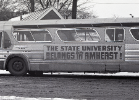News and views for the UB community
Campus News
Libraries’ exhibit looks back at 1967, a pivotal year for UB

Two female student examine a large outdoor map of the South Campus in 1967.
By MARCENE ROBINSON
Published March 22, 2017 This content is archived.
Fifty years ago, UB found itself at the forefront of national and international issues.
During the 1960s — a decade marked by cultural and political unrest due to the Vietnam War, the Civil Rights Movement and the assassination of President John F. Kennedy — UB became a hotbed of protest, earning the university the nickname “Berkeley of the East.”
Tensions escalated in 1967, arguably the most iconic year in UB’s history. From visits by Muhammed Ali and Martin Luther King Jr. to a Supreme Court case that altered First Amendment rights, the events and decisions of 1967 continue to resonate to this day at UB and beyond.
Through archival photographs, memorabilia, audio recording and other relics, the University Libraries invites the campus community to explore the pivotal year by visiting the exhibit “1967: A Definable Year for UB.”
The free exhibit is on display through April 28 in Special Collections, 420 Capen Hall, North Campus.
An open house for the exhibit, also free and open to the public, will be held from 4-6 p.m. March 30. Light refreshments will be served.
In addition to viewing photographs and memorabilia, guests can experience the period through digitized historical UB films and audio recordings on tablets installed within the exhibit. More than 130 digitized films are available for viewing online in the University Archives Historical Film Collection.
Defining moments for UB in 1967 include:
A Supreme Court decision redefines academic freedom
At the height of the Red Scare, communism was considered the greatest threat to the nation. For decades, a New York State law — known as the Feinberg law — required government employees, including UB faculty, to sign an oath that they were not members of the Communist Party and forbade them from speaking openly about communism.
However, five UB faculty members from the departments of English and Philosophy, and the UB Libraries refused to sign the oath and instead sued the New York State Board of Regents for violating their basic rights.
The case, Keyishian v. Board of Regents, escalated all the way to the Supreme Court, where the justices ruled in favor of the faculty. The decision became an important beacon for First Amendment advocates and allowed for the protection of academic freedom from political backlash.
Famous faces visit UB
UB was a popular stop on speaking tours during the late 1960s. Among the prominent figures to grace the campus stage were heavyweight boxing champion Muhammad Ali, civil rights leader Martin Luther King Jr., and Sen. Robert F. Kennedy, the 64th U.S. attorney general.
Each speaker touched on controversial topics at the time, including the Vietnam War, poverty and crime, difficulties facing African-Americans and improving relationships between law enforcement and communities.
New campus in Amherst or on the waterfront?
By the mid-1960s, UB had identified three locations for a new campus: across the street from the South Campus on the Grover Cleveland Golf Course, the waterfront near downtown Buffalo or the current site in Amherst. Amherst ultimately was chosen for its mostly undeveloped space and ease of access.
The enormous architectural undertaking drew the attention of the nation’s top architectural firms. One of the most notable submissions was the Bunshaft Plan, which called for a mile-long, multilevel megastructure that would house nearly the entire university. It was overwhelmingly rejected.
The final proposal utilized the concept of an academic spine with student housing and recreation on the periphery. But constraints on time and money forced construction to begin on multiple buildings before the designs were finalized.
A fight for The Spectrum
This editorial cartoon from The Spectrum reflects on censorship by the paper's printer, Partner's Press.
Flip through the April 14, 1967 issue of The Spectrum and you may notice an oddity — two completely blank pages. When the student newspaper’s printing service, Partner’s Press, refused to print what they believed were obscenities on the pages — and instead left the pages blank — students erupted and mounted campus-wide protests against the printer and the UB administration.
Meetings between President Martin Meyerson and students led to new resolutions that terminated The Spectrum’s contract with Partner’s Press and established policies that prevented future printers from censoring materials with the newspaper.
It is still unclear what Partner’s Press refused to print, but sources suggest the primary concern was a poem that it found offensive. To this day, the text and content of the poem remain unknown.

UB was a hotbed for student protests during the 1960s, earning the university the nickname “Berkeley of the East.”
Student protests reach boiling point
Some of the most iconic imagery from the late 1960s is of student activism and political protests. UB often served as the front line of conflict.
One of the most notable was a protest in December 1967 against the presence of campus recruiters from the CIA and Dow Chemical, the company that produced napalm. With resistance to the Vietnam War across the nation, hundreds of UB students marched to express their political frustration.
Renowned professor arrested for marijuana

Leslie Fiedler. Photo: Jac. de Nijs/Anefo - Nationaal Archief, CC
In May 1967, prominent UB English professor Leslie Fiedler was arrested, along with family members, for possession of marijuana, beginning a five-year legal battle.
The nature of the arrest and legitimacy of the charges were frequently questioned, citing that Fiedler’s position as faculty adviser to LEMAR, an organization that advocated for the legalization of marijuana, made him a target. In 1972, the charges were thrown out by the State Court of Appeals.
Fiedler eventually published “Being Busted,” chronicling his experiences throughout the affair.









